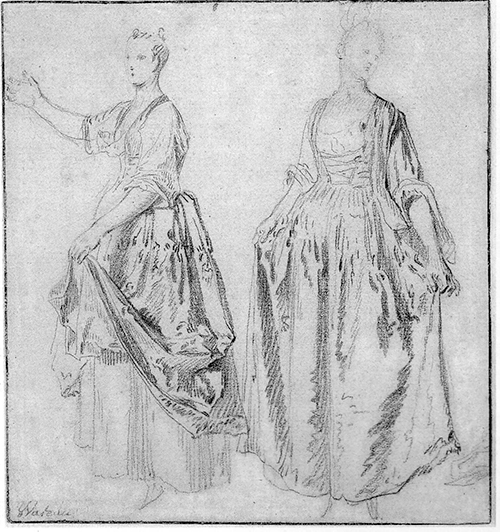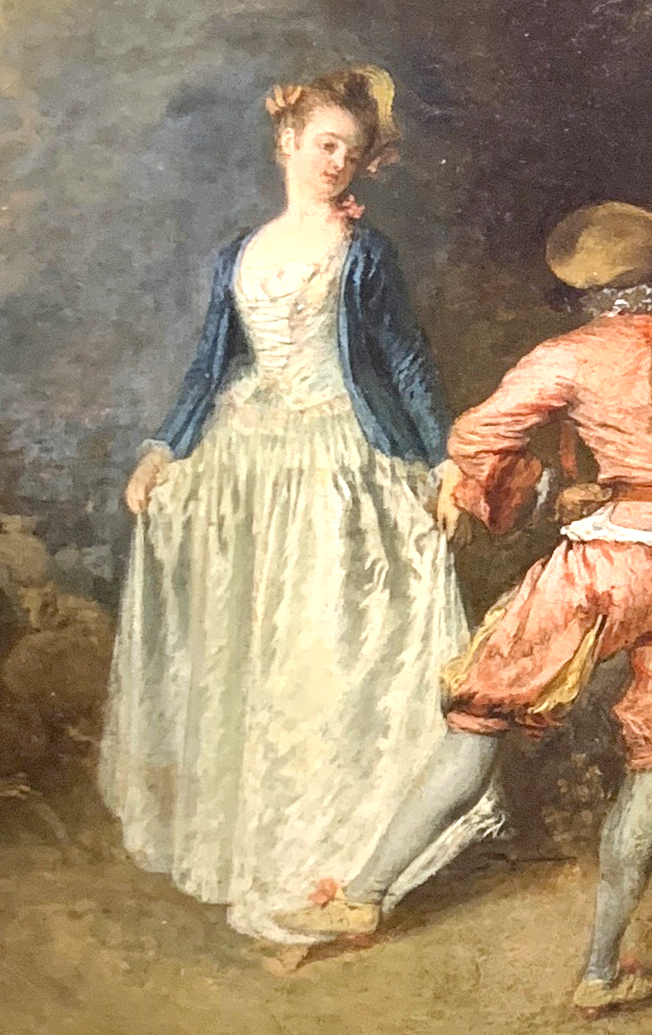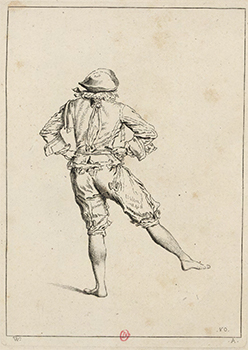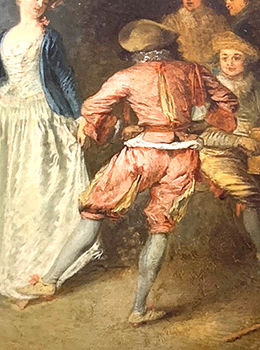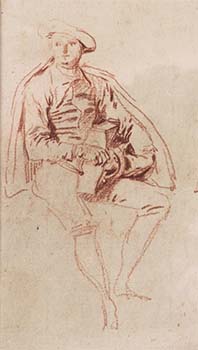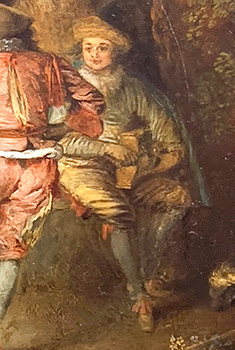
- Home Page
- Accepted
Paintings & Copies - Doubtful
Attributions - Doubtful Textual References
- Alternative
Titles - Collectors &
Museums - Bibliography
- Search Abecedario
- Watteau &
His Circle
La Danse paysanne
Entered February 2020
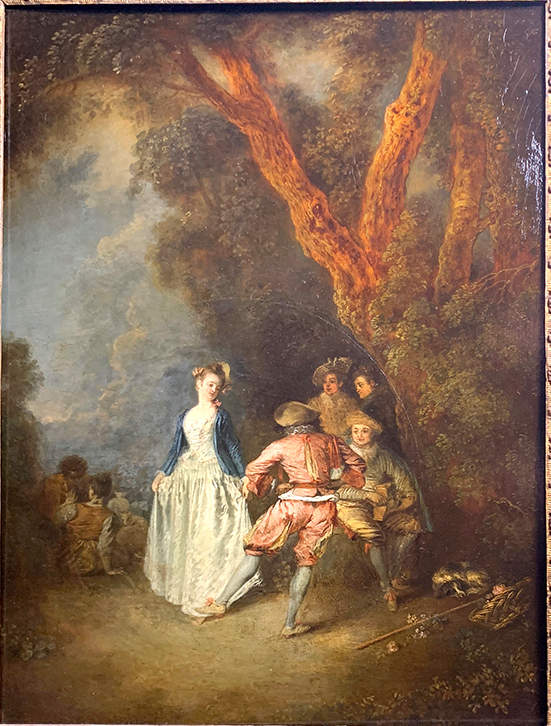
San Marino, California, The Huntington Library, Art Collections, and Botanical Gardens, Adele S. Browning Memorial Collection, gift of Mildred Browning Green and Honorable Lucius Peyton Green, inv. 78.20.19
Oil on panel
43.2 x 32.4 cm
ALTERNATIVE TITLES
Country Dance
RELATED PRINTS
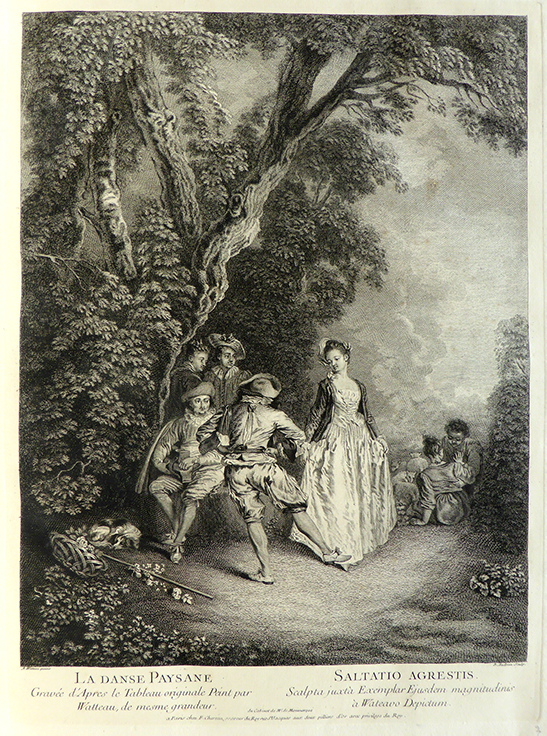
La Danse paysanne was engraved by Benoît II Audran. The commission to engrave the pendant painting, La Cascade, was entrusted to Gérard Scotin.
Dacier, Vuaflart, and Hérold cite an engraving by Claude Henri Watelet after La Danse paysanne that the artist included in his 1785 series Rymbranesques ou Essais de gravures. This print shows Watteau’s composition in a round format, reflecting the transformation of the original that occurred about then.
PROVENANCE
Collection of Mathieu de Monmerqué (d. 1749; entrepreneur des tapisseries du Roi aux Gobelins). His ownership is noted on Audran’s engraving of 1729: “du Cabinet de Mr de Monmerqué.” He cannot be the fermier génerale Monmerqué who died in 1717, but was undoubtedly one of his sons, Mathieu. As such, he probably knew of Watteau and his paintings through Julienne, whose own tapestry works were nearby.
Paris, collection of Monsieur Poullain (Receveur général des domaines du Roi). His sale, Paris, March 15-21, 1780, lot 113: “ANTOINE WATEAU . . . Deux Tableaux faisant pendans.
L’on voit, dans l’un, l’Intérieur d’un Bois, & des masses de paysage. Sur le devant est un Berger Espagnol dansant avec une jeune Femme au son d’une vielle dont joue un homme assis, derrière lequel sont debout deux autres personnages, qui les regardent, un chien est couché auprès de la pannière & de la houlette. Un peu plus loin un Berger veut embrasser une Bergère assise sur l’herbe, qui le repousse; leurs troupeaux sont auprès d’eux.
Dans l’autre, est un Bosquet orné d’un bassin avec des cascades. Un Espagnol & une Femme debout s’entretiennent ensemble, pendant qu’un autre homme & une autre femme assis font la conversation; à leurs pieds est assis un cinquième personnage jouant de la guitarre. Haut. 16 pouc. Largeur 12 pouces. B.” Sold for 610 livres the pair to the dealer Langlier.Paris, collection of Barthélémy Henri Loliée (Lollier) (prosecutor in the Chambre des Comptes). His sale, Paris, April 6ff, 1789, lot 54: “A. Watteau . . . Deux petits Tableaux de forme ronde, représentant des amusements champêtres; dans l’un, on compte cinq figures, dont un homme & une femme écoutant un personnage qui pince de la guitarre; dans l’autre on remarque un homme vêtu à l’Espagnole, qui danse avec une jeune dame. Ces deux Tableaux d’une touche spirituelle & de la plus riche couleur, ont toujours été considérés avec distinction. Ovale sur bois. Diamètre 7 pouces 6 lig.” Bought for 501 livres by Defer.
Paris, collection of Monsieur Lacaille. His sale, Paris, January 23ff, 1792, lot 56: “A. WATTEAU Deux petits tableaux de forme ronde, représentans des amusemens champêtres, un orné de sept figures, & l’autre de cinq sur des fonds de paysages, sur H. diametre 7 pou. B.” The paintings sold to Guenard [Gueried] for 180 livres, according to an annotated copy of the sale catalogue in the Frick Art Reference Library.
Paris and the Château de Moreuil, collection of Madame la Marquise de Plessis-Bellière (née de Pastoret). Her sale, Paris, May 10-11, 1897, lot 146: “WATTEAU (ANTOINE) (Attribué à) . . . La Danse paysanne. Dans un parc, un danseur vu de dos fait vis-à-vis à une jeune femme, vêtue d’une robe de satin blanc et d’une petite veste bleue. Sur la droite, au pied d’un grand arbre, un musicien les accompagne en jouant de la vielle, pendant que d’autres personnages contemplent cette scène. Au second plan, à gauche, un villageois lutine une jeune paysanne assise. H., 0m,42. L., 0m,32. . . La Promenade dans le Parc . . . . Ces deux tableaux, de forme primitivement ronde, ont été aggrandis.” Sold for 8,400 livres to Michel H. Michel-Levy, according to an annotated copy of the catalogue in the Rijksbureau voor Kunsthistorisches Documentatie (or 8,600 livres, according to other catalogues).
Paris, collection of Henri Michel-Lévy (1844-1914; artist). His sale, Paris, May 12-13, 1919, lot 26: “WATTEAU (JEAN-ANTOINE) PENDANT DU SUIVANT [La Cascade] . . . La Danse paysanne. Une jeune femme en robe blanche, manteau bleu, danse, au centre, tenant de ses deux mains les plis de sa jupe. Un danseur en rose, vu de dos et coiffé d’un chapeau de feutre, lui fait vis-à-vis. A droite, au pied d’un grand arbre, un joueur de vielle est assis. Derrière lui, deux personnages debout. A gauche, un couple en conversation galante. Dans le fond, des maisons. Au premier plan, un chien est couché près d’une corbeille de fleurs. Bois. Haut., 42 cent.; larg., 32 cent. Gravé par Audran. Collection du Plessis-Bellière, vente les 10-11 mai 1897, no 145 du catalogue, avec la mention attribué à. Cadre en bois sculpté.”
Paris (?), collection of Nicolas Eustache Ambatielos (1885-1956; shipbuilder).
Paris, with Wildenstein and Co. Sold on May 4, 1923, to Alvin Schmid for 325,000 FF.
Zurich, collection of Alvin Schmid.
Zurich, collection Fleischmann.
Zurich, collection of Rolf Lieberman; sold to Clyde Newhouse in 1955.New York, with Newhouse Galleries. Sold to Judge Lucius and Mrs. Mildred Browning Green, October 14, 1955 for $28,000; bequeathed to the Henry E. Huntington Library and Art Gallery.
EXHIBITIONS
Paris 1925, La Danse dans la peinture, cat. 9 (Watteau, Danse paysanne, lent by Alvin Schmid).
SELECT BIBLIOGRAPHY
Hédouin, “Watteau” (1845), 79.
Hédouin, Mosaïque (1856), cat. 69.
Goncourt, L’Art au XVIIIème siècle (1860).
Goncourt, Catalogue raisonné (1875), cat. 125.
Zimmermann, Watteau (1912), cat. ref. P83.
Dacier, Vuaflart, and Hérold, Jean de Jullienne et les graveurs (1921-29), 1: 164, 259; 2: 65, 96, 130; 3: cat. 27.
Courthion, “Collection Alwin Schmid” (1926), 57.
Réau, “Watteau” (1928), cat. 26.
London, Wallace Collection Catalogues (1928), 329.
Adhémar, Watteau (1950), cat. 117.
Valentiner, Collection of Lucius Green (1956), cat. 23.
Mathey, Watteau, peintures réapparues (1959), 68.
Macchia and Montagni, L’opera completa di Watteau (1968), cat. 134.
Roland Michel, Watteau (1981), cat. 166.
Roland Michel, Watteau (1984), 273.
Posner, Watteau (1984), 121, 160, 163.
Posner, “Country Dance” (1984), 26-31.
Wallace, McDonagh, et al, Dance (1986), 111-12.
Rosenberg and Prat, Watteau, Catalogue raisonné des dessins (1996), 123, 135.
Temperini, Watteau (2002), cat. 57.
Chrisman-Campbell in French Art of the Eighteenth Century (2008), 388-89, n. 23.
Brussels, Palais des beaux-arts, Watteau, Leçon de musique (2013), under cat. 117.
RELATED DRAWINGS
Several of Watteau’s drawings can be linked to the principal figures in La Danse paysanne.
The actress at the center of La Danse paysanne is based directly on a drawing from the Woodner collection (Rosenberg and Prat 123).
The drawing for the male dancer has not survived, but it was recorded in the Figures de différents caractères, plate 80, and it was also etched by the comte de Caylus. When painting this figure, Watteau inclined the torso slightly and brought the dancer’s left arm out, away from the body, perhaps intending to impart more spring to his movement.
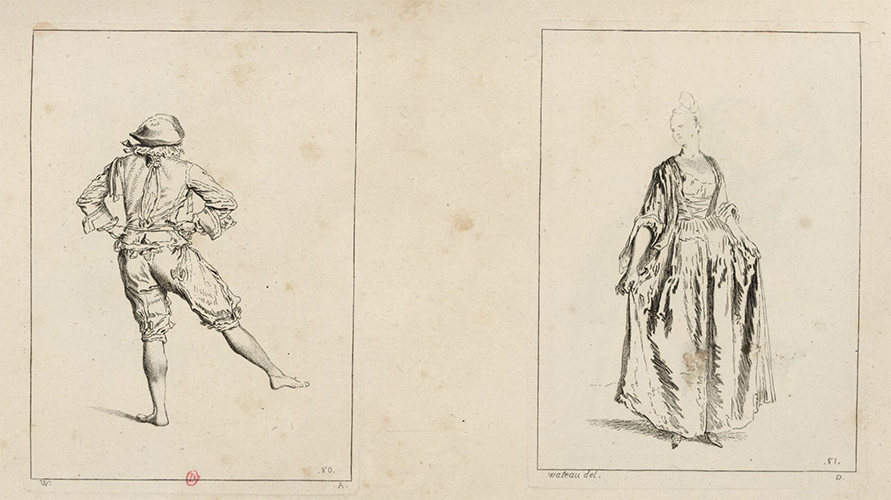
Critics have not considered the fact that following plate 80 in the Figures de différents caractères, the next engraving, executed by Louis Desplaces, is of the actor’s female partner. In effect, the juxtaposition of plates 80 and 81 recreates the painting. This is most unusual since the ordering of images in the Figures de différents caractères is almost entirely random. A notable exception is the pairing of plates 46 and 47, the male and female protagonists from L’Avanturière. In that instance Laurent Cars was undoubtedly working from an oil counterproof of the composition, now in the Louvre. What are the implications here apropos of La Danse paysanne? Was there such an oil counterproof from this painting as well? It is increasingly clear that making such counterproofs was more integral to Watteau’s studio practice than had been recognized.
The actor playing a vielle is based on a study in the Tylers Museum (Rosenberg and Prat 135).
REMARKS
From its inception, La Danse paysanne and La Cascade were planned as pendants—one featuring a dancing couple and the other a strolling couple. At some point after the 1780 Poullain sale and before the 1789 Lollié sale, Watteau’s rectangular pendants were cut down to circles and, as a result, their size was reduced from panels measuring 12 x 8 pouces to ones measuring only 7 pouces in diameter. (Roland Michel wrongly claimed that the paintings had originally been circular and were later inserted into rectangular formats.) The date of this change can be finessed even further, to some point between 1780 and 1785, because Watelet’s print of 1785 shows the composition in a circular format. In the nineteenth century, prior to the 1897 sale of the collection of the marquise de Plessis-Bellière, both panels were restored to their original rectangle by adding wood to the panel to recreate the original rectangular format, and copying the lost sections of foliage from the engravings. Despite these drastic physical changes, the two pendants remained together--until the Michel Levy sale in 1919. There they were presented as sequential but separate lots, and were sold to different purchasers.
Despite the title “Danse paysanne,” these are not peasants but, as their costumes indicate, theatrical figures playing the roles of peasants. Moreover, the dance portrayed is not a rural one but, rather, a courtly "danse à deux” in which the woman holds her skirt and seems to turn gracefully toward her partner as he executes a jump step.
The dating of this picture has varied from author to author, but the consensus places the picture in the artist’s mid-career. While Chrisman-Campbell and Mathey chose early dates of 1711 and 1713 respectively, and Posner selected 1714, most modern scholars prefer a date between 1715 and 1717. Adhémar proposed 1715, Roland Michel selected 1715-16, and Temperini preferred 1716-17, while Macchia and Montagni opted for 1717. Despite these minor variances, there is remarkable agreement.
Ambatielos’ ownership of the painting is noted in the catalogue cards of the Metropolitan Museum of Art for inv. no. 60.71.20, their copy of La Danse paysanne. That the painting had been with Fleischmann was claimed by Macchia and Montagni and others.
Click here for copies of La Danse Paysanne
